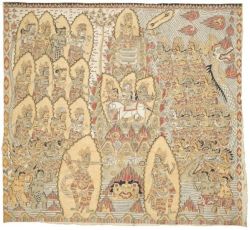Kamasan
- Style of painting.
Imagine you are a master Balinese painter, and your King has recently commissioned you to do a piece of work. As you sit down in front of a large cloth stretched upon a wooden frame with a pencil in hand, for a moment you contemplate the composition before beginning to sketch. The year is 1723. What would go through your mind?
Possibly you hear the clash and bang of metallic instruments of a Balinese ensemble. You visualize the cloth in front as a giant screen, with an audience seated on the opposite side. And you imagine yourself as a dalang (master puppeteer) manipulating puppets while bringing to life a mighty Hindu epic during a wayang kulit shadow theatre play.
Origins
The roots of the wayang puppet theatre, one of the original story-telling methods in the Balinese culture, may be traced back over 2,000 years to Indian traders who settled in Nusa Antara (Indonesia prior to being known as the Dutch East Indies), bringing with them their culture and Hindu religion. The wayang or classical style of Balinese painting is derived from the imagery that appears in this medium.
The paintings were made on processed bark, cotton cloth and wood and were used to decorate temples, pavilions, and the houses of the aristocracy, especially during temple ceremonies and festivals. Originally the work of artisans from the East Javanese Majapahit Empire (13-16th century), this style of painting expanded into Bali late in the 13th century and from the 16th to 20th centuries, the village of Kamasan, Klungkung, was the centre of classical Balinese art – and hence the Kamasan paintings.
The original works were a communal creation; the master artist shaped the composition, sketching in the details and outlines, and apprentices added the colours. These works were never signed by an individual and considered a collective expression of values and gratitude from the village to the Divine. Colours were created from natural materials mixed with water; i.e. iron oxide stone for brown, calcium from bones for white, ochre oxide clay for yellow, indigo leaves for blue, carbon soot or ink for black. Enamel paint introduced by the Chinese a few hundred years ago was used on wooden panels of pavilions and shrines, or upon glass.
Divine and demonic
The highly detailed, sacred narrative Kamasan paintings play an essential role within the Balinese culture functioning as a bridge communicating between two worlds: the material world humans inhabit and the immaterial world of the divine and demonic forces.
The artist functions as a medium translating the esoteric and invisible into a comprehendible visual language and bringing greater understandings to the mysteries of life according to scriptures and philosophies.
According to Dr. Adrian Vickers, Professor of Southeast Asian Studies at Sydney University, “The key to Kamasan painting’s sense of beauty is the beautiful flow of line and the pure flat figuration.”
For foreign audiences, the paintings, however, present difficulties in their understanding. Without a concept of the landscape in Balinese paintings, it’s about an arrangement of items on a flat surface akin to the shadow puppets against the screen in shadow theatre. Unlike Western modern art where paintings generally have one focal point, there is no central focal point to read the Kamasan narratives. Most of the paintings have multiple stories that may be read in all areas around the composition.
Looking at the painting, it is full of visual information to the extent that nothing stands out. Tight, generalized, often repetitive patterning, often of decorative motifs and combinations of graphic patterns are distributed all across the surface leaving little or no blank areas. Ornamental elements, rocks, flowers motifs and painted borders indicate Indian and Chinese influence from Chinese porcelain and Indian textiles.
“Adherence to established rules about the relative size of parts of figures related to measurements in the human body – in the Balinese perspective each measurement is seen as a human manifestation of elements that exist in the wider cosmos. Correctness of proportions is part of being in tune with the workings of divine forces in the world. Colours are also codified.” says Vickers in his book Balinese Art Paintings & Drawings of Bali 1800-2010. “Form evokes spirituality.”
The three realms
The two-dimensional Kamasan compositions generally depict three levels: the upper level is the realm of the Gods and the benevolent deities, the middle level is occupied by kings and the aristocracy, and the lower third belongs to humans and demonic manifestations. Details in facial features, costumes, body size and skin colour indicate specific rank, figure or character type. Darker skin and big bodies are typical of ogres, light skin and finely portioned bodies are Gods and kings. Rules control the depiction of forms; there are three or four types of eyes, five or six different postures and headdresses. The position of the hands indicates questions and answers, command and obedience.
The narratives are from the Hindu and Buddhist sacred texts of Javanese-Balinese folktales and romances: the Ramayana, Mahabharata, Sutasoma, Tantri, also from Panji. Astrological and earthquake charts are also depicted. Major mythological themes are rendered in great symmetry, while these paintings contain high moral standards and function to express honourable human virtues to society with the intent to encourage peace and harmony. A beautiful painting communicates balance, aesthetically and metaphorically, and is equated to the artist achieving union with the divine.
Traditional Kamasan painting is not static and keeps evolving as subtle changes have occurred over time as each artist has their own style, composition and use of colour. It is common that new works regularly replace old and damaged ones and hence Kamasan painting is an authentic living Balinese tradition.
https://indonesiaexpat.id/lifestyle/kamasan-paintings-bali/ en
The turning of Mount Mandara - Mangku Mura





